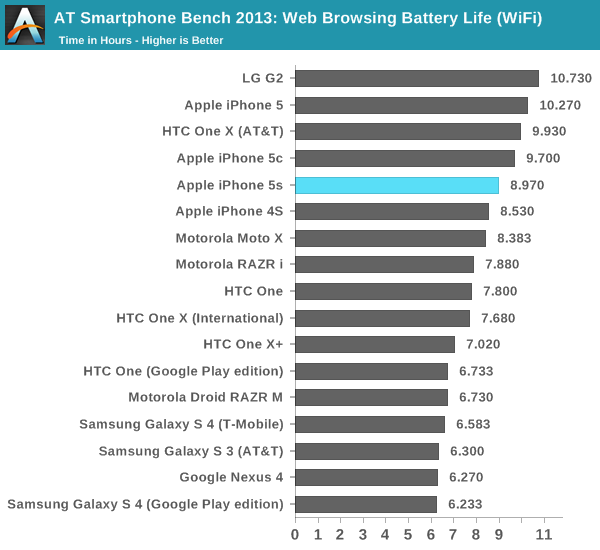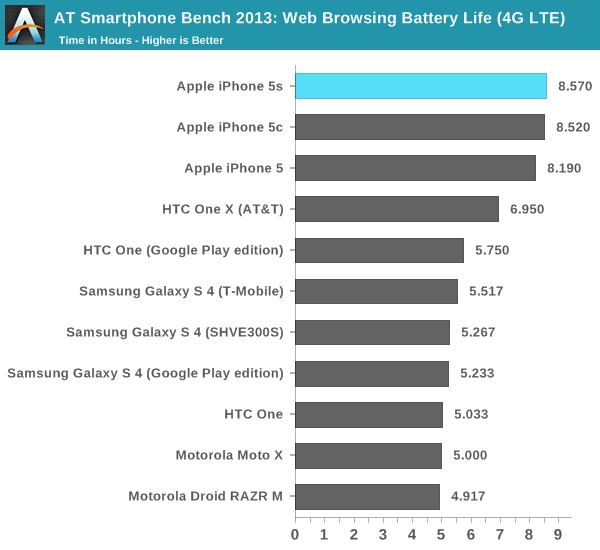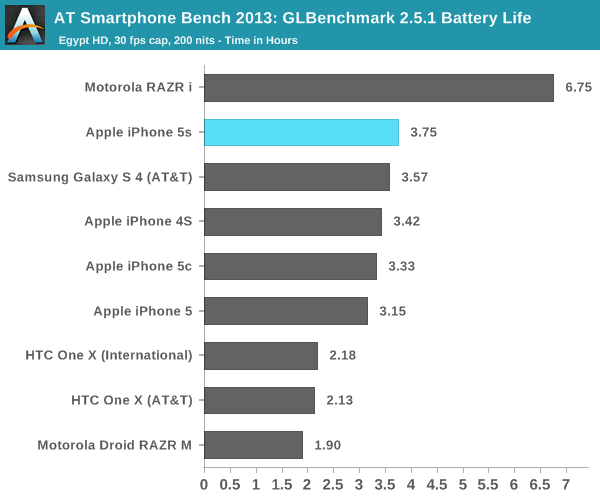The iPhone 5s Review
by Anand Lal Shimpi on September 17, 2013 9:01 PM EST- Posted in
- Smartphones
- Apple
- Mobile
- iPhone
- iPhone 5S
Battery Life
Brian did some excellent sleuthing and came across battery capacities for both the iPhone 5s and 5c in Apple’s FCC disclosures. The iPhone 5 had a 3.8V 5.45Wh battery, while the 5s boosts total capacity to 5.96Wh (an increase of 9.35%). The move to a 28nm process doesn’t come with all of the benefits of a full node shrink, and it’s likely not enough to completely offset the higher potential power draw of a much beefier SoC. Apple claims the same or better battery life on the 5s compared to the iPhone 5, in practice the answer is a bit more complicated.
Unlike previous designs, we’ve never had a half node shrink for an s-SKU. Both the iPhone 3GS and iPhone 4S stayed on the same process node as their predecessor and drove up performance. In the case of the 3GS, the performance gains outweighed their power cost, while in the case of the iPhone 4S we generally saw a regression.
The iPhone 5s improves power consumption by going to 28nm, but turns that savings into increased performance. The SoC also delivers a wider dynamic range of performance than we’ve ever seen from an Apple device. There’s as much CPU power here as the first 11-inch MacBook Air, and more GPU power than an iPad 4.
To find out the balance of power savings vs. additional performance I turned to our current battery life test suite, which we first introduced with the iPhone 5 review last year.
We'll start with our WiFi battery life test. As always, we regularly load web pages at a fixed interval until the battery dies (all displays are calibrated to 200 nits).

The iPhone 5s regresses a bit compared to the 5 in this test (~12% reduction despite the larger battery). We're loading web pages very aggressively here, likely keeping the A7 cores running at their most power hungry state. Even the 5c sees a bit of a regression compared to the 5, which makes me wonder if we're seeing some of the effects of an early iOS 7 release here.
The story on LTE is a bit different. Here we see a slight improvement in battery life compared to the iPhone 5, although the larger battery of the 5s doesn't seem to give it anything other than parity with the 5c:

Our cellular talk time test is almost entirely display and SoC independent, turning it mostly into a battery capacity test:

You can see the close grouping of the smaller iPhones at the bottom of the chart. There's a definite improvement in call time compared to the iPhone 5. We're finally up above iPhone 4S levels there.

Our Egypt HD based 3D battery life test gives us the first indication that Rogue, at least running fairly light code, can be more power efficient than the outgoing 5XT. Obviously the G6430 implemented here can run at fairly high performance levels, so I'm fully expecting peak power consumption to be worse but for more normal workloads there's no regression at all - a very good sign.










464 Comments
View All Comments
Abhip30 - Tuesday, September 24, 2013 - link
It's not cortex arm-a57. Since A6 apple uses arm achitecture. A6 was based on armv7 and A7 is custom design armv8.systemsonchip4 - Friday, September 20, 2013 - link
First consumer device to have ARM A57 processortipoo - Friday, September 20, 2013 - link
It's a custom core, not A57 or anything else from standard ARM designs.systemsonchip4 - Saturday, September 21, 2013 - link
Its a ARMv8 implementation, so yes it may be a little different then a cortex a57 SoC but it is still a ARMv8 Soc and that is why the A7 is able to beat the s800 SoC clocked at 2.3 ghzstevesous - Friday, September 20, 2013 - link
Every year, they say we will see that in next year's model,When will you guys finally get it?
yhselp - Saturday, September 21, 2013 - link
"Interestingly enough, I never really got any scratches on the back of my 5 - it’s the chamfers that took the biggest beating.""If you're considering one of these cases you might want to opt for a darker color as the edges of my case started to wear from constantly pulling the phone out of my pockets"
Hmm...
darkich - Sunday, September 22, 2013 - link
Alright, I'll make a bottom line of this review.. I accused Anand of being Apple biased, now I take that back.He is simply and clearly an INTEL fanboy, even while believing in his utmost objectivity.
He just can't help it.
Then again, when you think of the decades of omnopotent Intel influence he was growing up with, in a way, that bias becomes only natural and forgiving.
This is my message to you, Anand - Apple A7X will open your eyes real soon.
Even you won't be able to overlook the ridiculous magnitude of superiority of that SoC to your Bay Trail.
Mark these words.
Take care, Darko
yhselp - Monday, September 23, 2013 - link
It's not a matter of whether the A7/A7X is faster than a given Bay Trail variant, or at all. The fact of the matter is that Intel is sitting on some truly spectacular architectural IP and that's a scientific fact; the thing is that they can't seem to get it out in time. Bay Trail is but a 'baby', exceptionally conservative architecture whereas A7 or 'Cyclone' is not -- above all else it's wider.Apple/ARM is better or as-good this round and might continues to be in the future if Intel doesn't speed up it's game. That's true. However, even Intel's smaller architectures ARE superior to A7/ARM, let alone their big Core stuff (which isn't far from being synthesized for smartphone use); not to mention their manufacturing process advantage.
talg - Sunday, September 22, 2013 - link
Do you know from SoC point of view what function does A7 have ?justacousin - Sunday, September 22, 2013 - link
Based on some of my reading Samsung is the manufacturer of the A7 chip, what is to be said about this?